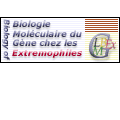
|
|















|
International Summer School
From Genome to Life:
Structural, Functional and Evolutionary approaches
WERNER Michel |
|
CEA/Saclay, Service de Biochimie et Génétique Moléculaire, Bâtiment 142, Gif-Sur-Yvette Cedex 91191, France title: Post-genomic study of the integration of transcription with other aspects of the nuclear metabolism and of the proteomic adaptation in response to cadmium in yeast. V. Bordas-Le Floch, B. Guglielmi, M. Fauchon, G. Lagniel, G. Gendrel-Lefeuvre, L. Lombardia, J.-C. Aude, J. Labarre and M. Werner Through three different examples, we will try to show how the use of various post-genomic global methods can help to understand aspects of S. cerevisiae biology and accelerate the discovery of novel phenomena. We have studied the response of yeast to the toxic metal, cadmium. This problem has been investigated using bidimensional electrophoresis of pulse-labeled proteins (which allows the measurement of translation rates) coupled to transcriptome analysis using DNA-microarrays and RT-PCR. The confrontation of these various methods has allowed us to demonstrate that (i) the response to cadmium is exclusively transcriptional; (ii) that a large part of the cell response resembles that provoked by other stresses; (iii) that contrarily to other stresses, cadmium strongly induces the sulfur amino acid metabolism; (iv) that the cell spares sulfur by lowering the global sulfur amino acid composition of its proteins and (v) that it adapts its proteome through the use of sulfur-poor isozymes. We have performed exhaustive two-hybrid screens to investigate the structure of yeast RNA polymerases and their interactions with proteins participating in other aspects of the nuclear metabolism. Strikingly, several proteins that interacted with RNA polymerase subunits belonged to the RSC complex. RSC is capable of remodeling the structure of chromatin in vitro and is essential for yeast survival. We studied the interaction of the Rpb5 subunit common to the three RNA polymerases with the Rsc4 subunit of RSC. We confirmed the interaction of RSC with the three RNA polymerases by co-immunoprecipitation. We obtained an rsc4 conditional mutant and showed that the mutation abolished the two-hybrid interaction with Rpb5. Moreover, the deletion of the Rsc4 region of interaction is lethal to the cell. The mutation led to a defect in Pol I and Pol III transcription. The consequences of the mutation on Pol II transcription were investigated using DNA microarrays. While 50 genes, the transcription of which was repressed two-fold or more at the restrictive temperature, are spread on the whole genome, of the 270 induced genes, 67% mapped to the chromosome XII. In yeast this chromosome bears the rDNA repeats strongly suggesting that RSC has a role in coordinating the transcription of the rDNA by Pol I and that of the Pol II genes located on chromosome XII. Since two-hybrid screening can lead to false protein interaction predictions, we have decided to apply a secondary screen to our data concerning interactions with the Pol I subunits. Pol I transcription occurs in the nucleolus. Thus, we have tagged a number of proteins selected in our screens to image them by indirect immunofluorescence. We localized a subset of the proteins in the nucleolus. Cluster analysis of gene expression patterns in yeast submitted to various stresses indicated that genes that are required for the maintenance of the translational capacity (coding for ribosomal proteins, proteins required for rRNA modification or maturation, Pol I and III subunits, tRNA modification enzymes, etc.) are coordinately repressed. Strikingly, some of the nucleolar proteins we identified responded similarly. We found that one of these proteins, which we named Gno1p is required for rRNA and snoRNA maturation. The human homolog of Gno1p is functional in yeast but is, in addition, necessary for telomere length maintenance in human cells. |